Villa of the Nile Mosaic
Lepcis Magna: Phoenician colony, later part of the Carthaginian empire, the kingdom of Massinissa, and the Roman empire. Its most famous son was the emperor Septimius Severus (r.193-211).
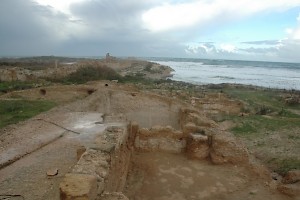
The Villa Nile or, to be precise, the Villa of the Nile Mosaic, is situated near the port of the ancient city of Lepcis Magna. It is named after three mosaics from the second century with Nilotic scenes that were excavated inside this mansion, which was situated close to the beach. Pictures of the river Nile were common in the ancient world: near Lepcis, they have also been found in the Villa Selene and the Villa Dar Buc Ammera.
The first mosaic shows a ship entering a port that may resemble the one at Lepcis Magna with its temple of Jupiter Dolichenus, which was visible from the Villa Nile. Several erotes accompany the boat; one of them has discovered an interesting way of windsurfing (using anamphora as board).
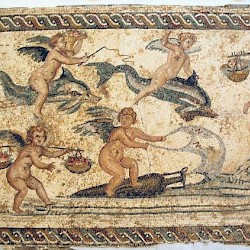 Villa of the Nile Mosaic, first mosaic |
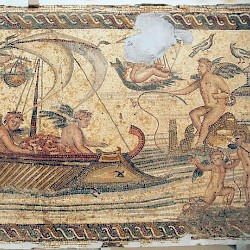 Villa of the Nile Mosaic, first mosaic |
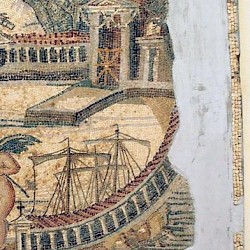 Villa of the Nile Mosaic, first mosaic: the port of Lepcis Magna |
The second mosaic represents the Nile flood. The symbolism of this work of art, which explains the name of the villa, is quite complex. To the right, we see two bald priests welcoming the waters: the river god is shown to the left, sitting on a hippopotamus. (Like most ancients, the maker had probably never seen a hippo; his representation is not better than the description by Herodotus of Halicarnassus.) All in all, fourteen figures - twelve erotes and two ladies - are in the procession. The number fourteen represents the fourteen cubits of a good Nile flood; the two ladies also represent Upper and Lower Egypt. Finally, the herm to the right reads Agathe Tyche, "good luck".
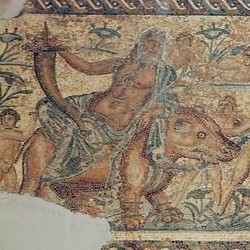 Villa of the Nile Mosaic, second mosaic |
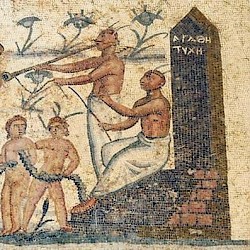 Villa of the Nile Mosaic, second mosaic |
The third mosaic is probably the best: it shows several fishermen at work.
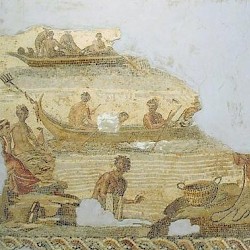 Villa of the Nile Mosaic, third mosaic, fishing boats |
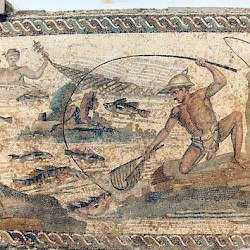 Villa of the Nile Mosaic, third mosaic, fishermen |
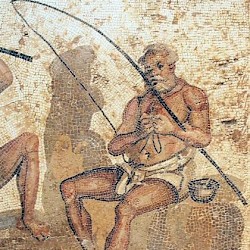 Villa of the Nile Mosaic, third mosaic, fishermen |
The fourth mosaic has a different theme and may have been made a bit later than the three first works of art. It shows how six ladies who are washing the winged horse Pegasus. I am not aware of any ancient myth about this subject.
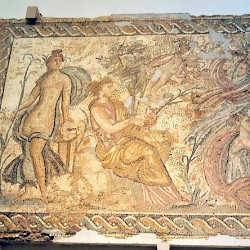 Fourth mosaic, ladies |
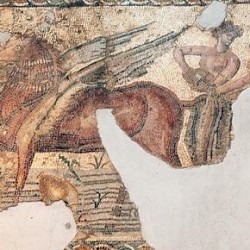 Fourth mosaic, Pegasus |
There are several other mosaics of hunting scenes (below). They were added in the fourth century. One of them, quite damaged, shows several people, some on horseback, trying to kill a boar. Another one shows a lion hunt. The lion chase was a typical activity of the nobility of ancient Libya, also mentioned in the works of Synesius of Cyrene, a younger contemporary of the artists who created the hunting mosaics in the Villa Nile.
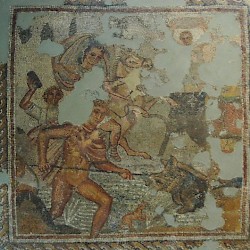 Villa of the Nile Mosaic, Hunting scene |
 Villa of the Nile Mosaic, Hunting scene |
All these mosaics can be seen in Libya's beautiful National Archaeological Museum in Tripoli.